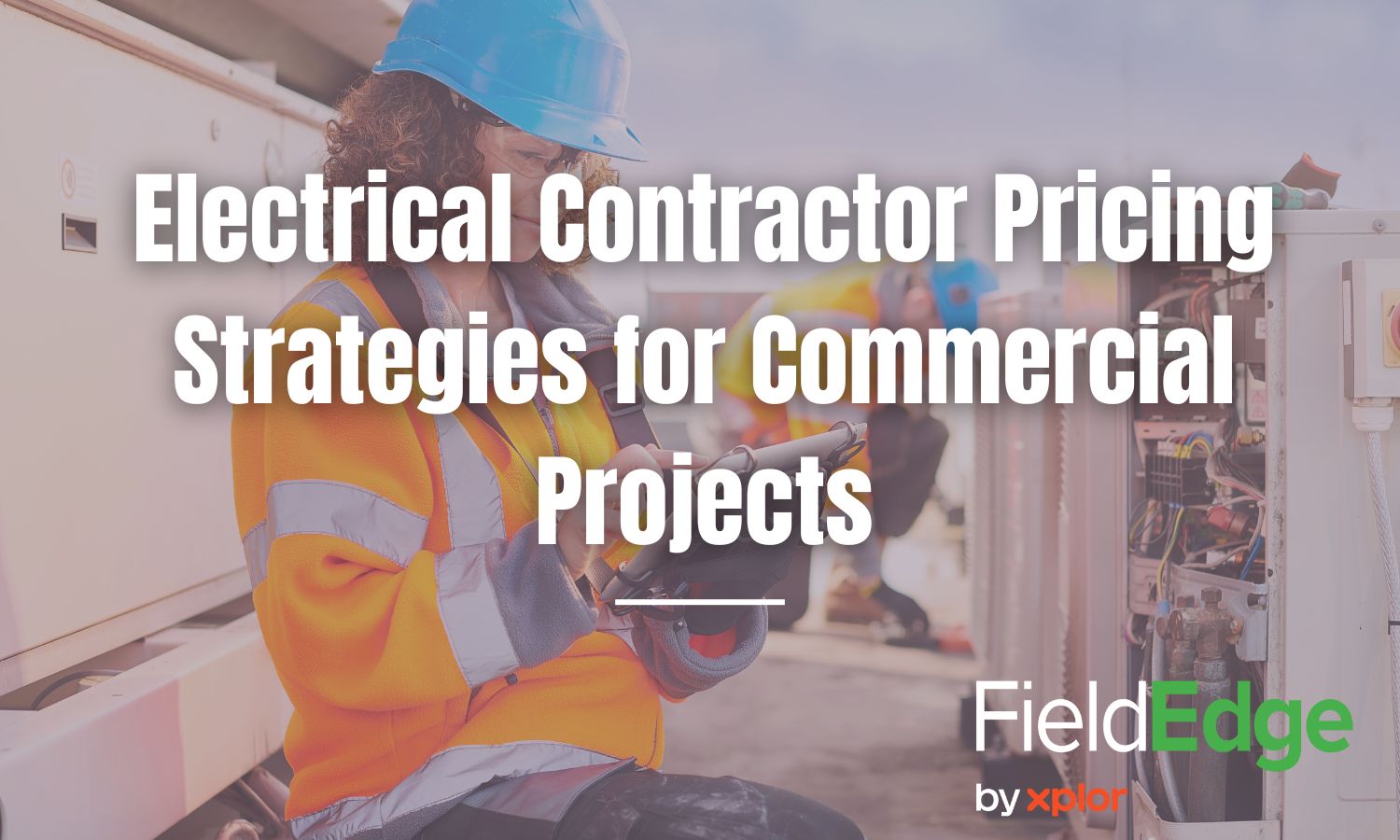Getting your electrical contractor pricing right isn’t just about landing work; it’s about protecting your margins, your team, and your sanity.
If you charge too little, you’ll stay busy but barely profit. If you charge too much, you’ll get underbid by competitors.
Finding the sweet spot with your electrical contractor pricing is the difference between staying afloat and scaling profitably, especially for commercial and MM1 contractors.
In this guide, we’ll break down real-world pricing strategies used by profitable electrical businesses, including:
- How to calculate costs so you stop guessing
- Different electrical contractor pricing methods that work best for commercial jobs
- Ways to stay competitive without losing money
- Common pricing mistakes (and how to avoid them)
- Tips for presenting quotes that win more bids
Start With Your True Costs
“Materials + labor + markup” isn’t enough. Before you can set good prices, you need to know what things really cost you. Many electrical contractors only think about the obvious stuff like wire and conduit. But there’s so much more.
For instance, labor costs make up about 40-50% of total construction project expenses.
Remember, commercial work comes with:
- More risk
- More labor hours
- More coordination
- More compliance
- Longer project timelines
So your electrical contractor pricing has to account for everything.
Your real costs include:
- Wages and benefits
- Truck, fuel, and fleet maintenance
- Insurance (general liability, worker’s comp, vehicle)
- Tools, PPE, depreciation, and equipment
- Office overhead
- Electrician software
- Permits and compliance fees
- Marketing and sales costs
Pro Tip! Add all these up for a month, then divide by your billable hours. This tells you your break-even rate. You need to charge more than this to actually make profit.
Electrical Contractor Pricing Methods That Actually Work for Commercial Projects
There are several ways to price commercial electrical work. Each has pros and cons.
1. Time and Materials (T&M)
This is when you charge for your hourly rate + materials. For example, you might charge $85 per hour plus materials at cost, or materials plus a markup (like 20%).
This works well when:
- The project scope isn’t clear yet
- There might be surprise issues
- The client wants flexibility to make changes
While it’s not ideal for customers who want a firm budget, it is one of the most common electrical contractor pricing methods.
2. Flat Rate Pricing
You bid one price for the whole job, no matter how long it takes. If you estimate a job at $12,000, that’s what the customer pays.
This works well when:
- You know the job well
- You want to reward efficiency
- Customers want budget certainty
- The scope is tightly defined
MM1 contractors use flat-rate pricing to protect margins, especially when you’re moving multiple crews through multi-phase projects.
3. Value-Based Pricing
This is where profitable contractors thrive. This means charging based on the value you bring, not just time and materials.
If your work helps a restaurant open two weeks early, that’s worth a lot to them. Your electrical contractor pricing should reflect that value.
How to Bid Accurate Commercial Bids (Simple Breakdown)
Commercial electrical contractor pricing requires careful estimating. Here’s a simple breakdown:
| Cost Category | How to Calculate | Example Amount |
| Direct Labor | Hours × Wage Rate × 1.5 (burden) | $8,500 |
| Materials | Takeoff list + 10% waste | $12,300 |
| Equipment | Rentals + tool depreciation | $1,800 |
| Overhead | Monthly OH ÷ jobs | $3,200 |
| Profit Margin | Total costs × 15-25% | $5,100 |
| Total Bid | $30,900 |
According to the Construction Financial Management Association, successful electrical contractors aim for 15-20% net profit on commercial projects. Which means, if you’re consistently under 12%, your pricing structure needs adjusting.
How to Stay Competitive Without Undercutting Yourself
Good electrical contractor pricing doesn’t mean being the cheapest. It means being the best value.
Here’s how to stay competitive:
- Know your market. What are other contractors charging in your area? You don’t need to match them, but you should know the range.
- Sell your value, not just a number. Don’t just hand over a number. Explain what makes your work worth it. Maybe you finish faster, offer better warranties or have fewer callbacks.
- Stick to your timelines. Commercial clients care about schedules. If you can commit to dates and hit them, that’s worth money to them.
Big Pricing Mistakes Even Experienced Contractors Make
Even experienced contractors make these mistakes with their electrical contractor pricing:
1. Doing Free Change Orders
Scope creep is the silent killer. Changes happen on commercial jobs. Build a process for pricing changes into your contracts. Don’t do extra work for free hoping to keep the client happy.
2. Underestimating Labor
Be realistic about how long tasks take. Track actual hours per task to get better at estimating. Add buffer time for unexpected issues. Remember, MM1s rely on historical data, not gut instinct.
3. Ignoring Overhead
Some contractors forget to include overhead costs in their electrical contractor pricing. Your office manager, truck payment, and insurance need to be covered by every job. SMBs do this constantly; whereas, MM1s who scale successfully price overhead into every bid.
4. Racing to the Bottom
If you win every bid, your electrical contractor pricing is too low. However, if you win none, you’re either too high or need to communicate your value better.
Keep in mind, dropping your prices to beat competitors usually backfires. You win jobs you can’t afford to do. Better to lose a bid than lose money doing the work.
Presenting Your Pricing Professionally (Presentation Wins Bids!)
How you present your electrical contractor pricing matters just as much as the numbers. A polished quote is worth more than a handwritten number on a PDF.
Commercial clients expect a professional proposal that includes:
- Clear scope of work
- Line-item breakdowns
- Payment schedule
- Credentials and insurance
- Warranty terms
Speed matters too. Contractors who send proposals within 24 hours win 25% more jobs.
Electrician software like FieldEdge help commercial electrical teams send professional, branded proposals instantly—and track when clients open them.
Book a FREE demo of FieldEdge today to experience how the best service software will BOOST your business growth!
Adjusting Prices at Scale
Here’s the pricing truth most contractors learn too late: If you’re booked solid for 4–6 weeks, you need to raise prices.
Track your metrics:
- Win rate (aim for 30-40%)
- Average profit per job
- Customer acquisition cost
- Repeat customer rate
Even a 5% bump in your electrical contractor pricing can significantly improve margins over the year.
Accurately Price Your Electrical Contractor Projects
Smart electrical contractor pricing is the foundation of a profitable electrical business. It’s not about being the cheapest or the most expensive. It’s about knowing your costs, understanding your value and charging fairly for both.
Remember these key takeaways:
- Know your true costs
- Sell your value
- Present your margins
- Present your bids professionally
- Walk away from bad-fit clients
The electrical contracting industry is growing and is expected to grow 3.94% annually through 2028. With smart pricing strategies, your business can capture its share of that growth.
Your electrical contractor pricing tells customers what you’re worth. Make sure it reflects the quality, reliability, and expertise you bring to every commercial project.
Book a FieldEdge demo to see how proposals, estimating, and job costing become faster—and far more profitable!
Related: Emergency Electrical Service: Best Practices for 24/7 Electrician Operations



